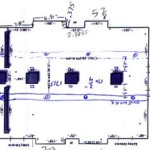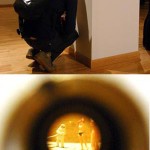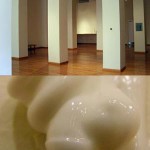By CHRISTIAN HOLLAND
Liz Nofziger is an artist with bright orange-red highlights in her hair and robustly rimmed glasses that remind me of the pair an old carpenter might wear in his (or her) woodshop. Her glasses may be just as appropriate to her vocation as they are to a carpenter’s as her rather cavernous studio was filled with two-by-fours and various equipment for the manipulation of building materials. I had followed my way along the sketchy map she drew, in the same fashion she uses to map out and design her installations, to get from the T-station to her work space and we began a chat about what she’s been working on for the last ten months or so. In June of last year, she visited the Glass Curtain Gallery of Columbia College in Chicago in preparation for her solo show, Core, which just opened on March 12th.
In many ways, Core is a breakthrough show for Nofziger. The Glass Curtain Gallery has been providing her with more support than she’s ever gotten for any previous shows and much more support than she expected. Core is entirely carpentry dependent and Columbia College has provided a team of not only students devoted to the gallery, but a staff of preparators who have helped Nofziger build a meticulous installation that has fundamentally transformed the 2200 square foot layout of the space (incidentally the same size as the Boston Center for the Arts’s Mills Gallery). Nofziger isn’t a neophyte in the art world—she has been showing work for a decade now—however, after she moved to Boston from her native Kentucky in 2002 to begin an MFA at MassArt (2004), her career began to change scale.
After several well received solo shows over the last two and a half years following her graduation from MassArt, (her C.V. lists 10, including her thesis show, up to the present) Nofziger sought to be an Artist in Research (AIR) at the Berwick Research Institute. She spent her time in AIR program planning for her show at the Glass Curtain Gallery, essentially in an R&D phase of the project, and unlike all other AIR’s, had no work to show at the end of her spell at the Berwick. She hoped to extrapolate from her research at the Berwick an installation at The Glass Curtain, and completed the AIR program essentially with a set of architectural plans.
Working like this was a challenge for Nofziger as well as AIR curators Bonnie Bastien and Rosie Branson Gill. She typically works very spontaneous when creating work, much of it comes as a response to the spaces in which she builds her installations, so several months of planning presented quite hurdle for her. Indeed, the challenge for the curators came in that they didn’t have the certainty that physical work provides in a normal curator/artist relationship. Nofziger admits that being in the AIR program was like being back in school as Bastien and Branson-Gill guided her through her research. For much of the time, she set out to examine her own art-making process, and a major aspect of the exhibit at The Glass Curtain is devoted to just that.
Core is about the building that houses The Glass Curtain Gallery and its history. The Ludington Building (1891), is one of the earliest “skyscrapers” and its architect, William LeBaron Jenney, is known by some as the “Father of the American Skyscraper.” Jenney was part of the Chicago School of Architecture, which was in large part responsible for innovations such as a steel skeleton and “curtain” (non-load bearing) exterior wall in their buildings, from which the Glass Curtain Gallery took its name.
After visiting the gallery, Nofziger actually grappled with the fact that there were 3 large, 18 foot-high, pillars, all part of the building’s steel skeleton, running down the center of the gallery. Her solution was to build six more pillars, two rows on either side of the actual pillars. When she finished, gallery appeared to be an empty space overbuilt with support for its roof with nine 18-inch square pillars. Each one of her pillars contains elements that Nofziger developed from the history of the space. Each one is a ‘core sample’ from the building’s long history, revealing an ‘impression’ of one of the building’s previous eras.
The building was commissioned for the American Book Company by Mary Ludington and one of the pillars contains space shakers, very low sub-woofers, which emulate the sound of a building filled with large paper printing machinery. It was later owned by Pepsodent toothpaste and Nofziger added a tube of White Mint Pepsodent toothpaste to one of the columns, its contents oozing right down the side of the column itself. After Pepsodent, the building was auto parts storage facility and Nofziger added a muffler piercing a column. Viewers can look inside the muffler and view scenarios which Nofziger created with the figurines she commonly uses in her work. She didn’t leave out the Great Chicago Fire of 1871, which she brings forth with a video installation, incorporating a mirror that enables viewers to envision themselves surrounded by flames.
Nofziger refers to each of these elements as “interventions” and snickers to herself when I question her use of this word. It’s as if she’s just accidentally revealed her true intentions of remaking the gallery space so as to affect each visitor’s state of mind, confusing them by dramatically altering the space while offering only suggestions of the building’s past within the new structures. She doesn’t expect most people to necessarily make the connection between any of the elements. She is essentially interested in the mere confrontation a gallery visitor might have with a space crowded with columns and following that up with much more intimate experiences she can provide with each one of her elements. Each element is a piece of history distilled down to an experience which is more visceral than anything else.
Nofziger is thinking about this essential thing, “the core,” but also the removal of this essential thing, in a sense also examining the paradoxicality of the word. By focusing on the core of the building, (the skeleton) she removes it from the context of the building’s manifest structure and into the mind of the gallery visitor as a concept.
To this end, Nofziger may not be necessarily be enabling the visitors to readily understand the building’s actual history by presenting them with her so-called interventions, however, what she does provide is her idiosyncratic aesthetic which is not so abstract that it alienates the viewers despite bemusing them. She does not think it matters whether they have been in the space altogether. She doesn’t seek to provide a history in the sense of a text book, yet wishes to incite the gallery visitor to respond to the space in a way that they would be unable to in its ordinary state. Nofziger is hoping people consider the pillars as if they are all real and their seamless construction will enable them to do so. The installation engages visitors by virtue that they can no longer take the building’s structure for granted as they are immersed in structure itself while the new pillars perfectly mimic the actual load bearing structures of the building. As each pillar, real and artificial, has the precisely the same semblance, they each command the same subconscious respect any structure would which holds countless tons of glass, concrete and steel above one’s head.
Much of Nofziger’s work is dedicated to slightly disconcerting its viewer, and Core is by no means an exception. It is the discomfort that the work provides which makes it successful, and I encourage you to seek out discomfort, courtesy of Liz Nofziger, whenever you get a chance.
- The Glass Curtain Gallery’s floor-plan with Nofziger’s notes.
- A gallery visitor peers into on of Nofziger’s columns and one of several models the viewer may see.
- An installation view of The Glass Curtain Gallery and a detail of the Pepsodent column. Nofziger added six identical columns to the three that already existed.
Glass Curtain Gallery of Columbia College, Chicago
Hear Liz Nofziger on Chicago's art podcast Bad At Sports.
Read James Manning's conversation with Liz Nofziger in Big RED and Shiny, Issue #30.
"CORE" is on view through April 20 at The Glass Curtain Gallery at Columbia College, Chicago.
All images are courtesy of the artist and Glass Curtain Gallery.






